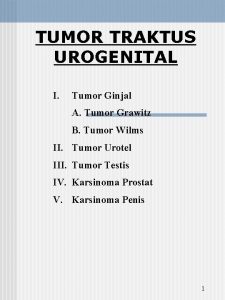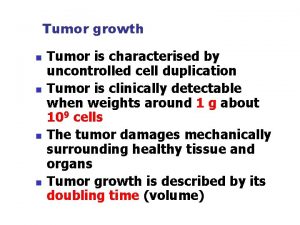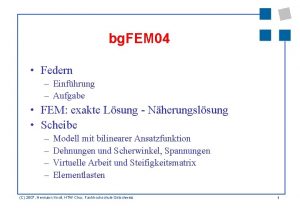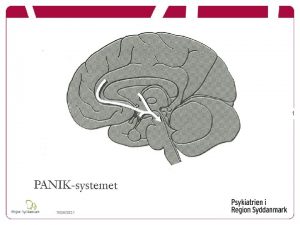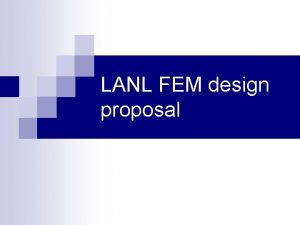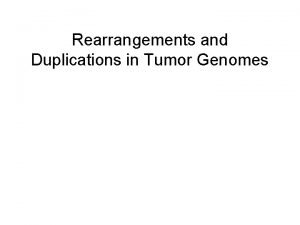FEM Model for Tumor Growth Analysis Presenter Liu







































- Slides: 39

FEM Model for Tumor Growth Analysis Presenter: Liu Changyu(刘昌余) Supervisor: Prof. Shoubin Dong(董守斌) Field : High Performance Computing Otc. 10 th, 2012

Contents l l l Basic Model Definitions Differential of a triangle area to its three vertex’s coordinates Differential of a tetrahedron volume to its three vertex’s coordinates Algorithm for meshing the initial cell Algorithm for cell division 2

Three phases for tumor growth 1. Avascular phase 2. Angiogenesis 3 3. Vascular tumor growth

Avascular tumor growth phases 1. PRE:Day 2 2. MID:Day 10 3. LAST:Day 18 4

Tumor total energy and Its Increment l Tumor total energy l After cells have growth, the energy may changed as 5

Energy Increment in Forms of Nodal Displacement l l l Transmission of local nodal displacement vector {u}AL_C to global nodal displacement vector {u} [T] is a 3 NLN× 3 NN transform matrix, each element in it is 1 or 0 Then, 6

Energy Increment in Forms of Nodal Displacement (Cont’) l Increment of a cell l Increment of a minor area l Energy increment 7

Minimum Energy Principle l l For all possible surface displacements {u} of cells, the real one make the energy increment △H minimum. Finite element equation 8

Tumor Growth Stiffness Matrix & Tumor Growth Driving Force l Tumor growth stiffness matrix l Tumor growth driving force l FEM Equation 9

Contents l l l Basic model Definitions Differential of a triangle area to its three vertex’s coordinates Differential of a tetrahedron volume to its three vertex’s coordinates Algorithm for meshing the initial cell Algorithm for cell division 10

Some Parameters for the Elemental Description of the Tumor Cells l Cell: – CN: Current total cell number, at beginning CN=1, then CN=CN+1 in the case of a cell splitting – C: Serial number of each cell, range of C is 1~CN l Minor Areas: – – – AN: Global total minor surface number A: Global serial number of a minor surface ALN: Local total minor surface number is a cell AL: Local serial number of a minor surface in a cell LA: It is a two dimensional array which links a local surface number to its global surface number. LA(C, AL)=A 11

Some Parameters for the Elemental Description of the Tumor Cells l Nodes: – NN: Total nodal number – N: Global serial nodal number – NLN: Total nodal number in a minor surface, now NLN=3 – NL: Local serial nodal number in a surface, now NL=1, 2, 3 – LN: It a three dimensional array, which links a local node number to its global node number. LN(C, NL)=N 12

Some Parameters for the Elemental Description of the Tumor Cells l Minor Area and its Nodes Relation Arrays – – – : The first node of a minor area; : The second node of a minor area; : The third node of a minor area; 13

Some Parameters for the Elemental Description of the Tumor Cells l Coordinates and displacements of nodes: – – – l x: coordinates of nodes in x axis, x(N) y: coordinates of nodes in y axis, y(N) z: coordinates of nodes in z axis, z(N) u: x directional displacement of nodes, u(N) v: y directional displacement of nodes, v(N) w: z directional displacement of nodes, w(N) Surface property: – J: the surface energy in a unit area, which will have different value correspondent to the surface contact property. 14

Contents l l l l Basic ideas Definitions Differential of a triangle area to its three vertex’s coordinates Differential of a tetrahedron volume to its three vertex’s coordinates Finite Element Equations Algorithm for meshing the initial cell Algorithm for cell division 15

Geometry l S 123 is a minor surface of a cell surface, O is the 2(x 2, y 2, z 2) centroid of the cell z 1(x 1, y 1, z 1) 3(x 3, y 3, z 3) O (0, 0, 0) y x 16

Area Expression l Because l Define a area vector 17

Differential of the Area According to Lagrange identity 18

Differential of the Area (Cont’) l Side’s relation within a triangle l Final expression of differential area 19

Differential and Dispalcement l In the finite element model 20

Nodal Displacement Vector and Surface Spring Vector Nodal Displacement Vector Surface Spring Vector 21

Differential Area in Form of Matrix l l Differential area Introduce a note “AL_C” to representative the minor surface “AL” in Cell “C” 22

Contents l l l Basic model Definitions Differential of a triangle area to its three vertex’s coordinates Differential of a tetrahedron volume to its three vertex’s coordinates Algorithm for meshing the initial cell Algorithm for cell division 23

Volume of a Tetrahedron l Volume of a tetrahedron can be expressed as 2(x 2, y 2, z 2) z 1(x 1, y 1, z 1) 3(x 3, y 3, z 3) O (0, 0, 0) x 24 y

Differential Volume l Differential to a tetrahedron volume l According to vector’s identify l Differential volume 25

Differential Volume in Form of Matrix l A volume spring vector 26

Differential Volume in Form of Matrix (Cont’) l Differential volume in form of matrix l Similar to the area form 27

Contents l l l Basic model Definitions Differential of a triangle area to its three vertex’s coordinates Differential of a tetrahedron volume to its three vertex’s coordinates Algorithm for meshing the initial cell Algorithm for cell division 28

Meshing Overview l l Homogeneous equilateral triangle Nodal Ring used i=0 Cell is divided into 2 n 7 i=1 sections equably in space interval ∈[0, ] i=2 18 19 35 i=3 i counter is for the 36 37 increment of j counter is for the Longitude L 5 increment of x 29 z Element Belt 1 ⑥ 2 8 ⑦ ① ⑧ 9 i=1 ② 4 i=2 3 12 ⑩ 11 ⑨ 10 i=3 26 25 20 21 o 22 23 24 y Longitude L 0 Longitude L 1 Longitude L 2

Meshing Algorithm l Local node number – Increase the nodal number with the increment of i, j; – From top pole to the equatorial nodal ring, the increment of the nodal number is 6, – After equatorial nodal ring, the nodal number inversely reduces in each nodal ring – Nodal coordinates 30

Meshing Algorithm l Local area number z – Increasing with nodal Nodal Ring i=0 number; 7 – Increasing once with i=1 18 nodes located on a i=2 19 longitude; 35 i=3 – Increasing twice with 36 37 other nodes – The element number in Longitude L 5 each element belt is x 6*(2 i-1) before n l Detail seen the program 31 Element Belt 1 ⑥ 2 8 ⑦ ① ⑧ 9 i=1 ② 4 i=2 3 12 ⑩ 11 ⑨ 10 i=3 26 25 20 21 o 22 23 24 y Longitude L 0 Longitude L 1 Longitude L 2

Contents l l l Basic model Definitions Differential of a triangle area to its three vertex’s coordinates Differential of a tetrahedron volume to its three vertex’s coordinates Algorithm for meshing the initial cell Algorithm for cell division 32

Aims of the algorithm for the cell division l l To choose to proper spatial surfaces to “cut” a cell C into two cells C 1, C 2 under the condition of averaging the cell’s volume; To mesh the new cut surfaces for the two cells 33

Calculating the Half Volume l Cone shell – Area belt connected to the centroid – Volume of a cone shell Vi l l i=1 i=2 Dome volume DVi, i=3 Rule to judge the half volume 34 O

Meshing new interface l l l Connecting C to the 6 nodes located on the longitudes get 6 radial lines; Inserting (n-abs(n-k))-1 nodes equably in each radial lines; Connecting new nodes in same radial layer sequentially from inner to outer; From inner to outer radial layer, each new circumferential line section is inserted 0, 1, …, (nabs(n-k))-1 nodes equably; All nodes connecting their neighbor nodes to consist triangle elements 35

Meshing new interface L 4 L 4 L 3 L 3 L 5 L 5 C L 0 C L 2 L 1 C L 2 L 0 L 1 36 L 0 L 2 L 1

Heritage Nodal and Elemental Number from Undivided Cell l Cell C 1 – The nodal number and element number before the k element belt will inherit from the cell C directly l Cell C 2 – Renumber both the element number and nodal number inversely in cell C – Change the nodal number in each nodal ring to match the nodal – Nodal number and element number before the (2 n-k) element belt of cell C 2 can inherit from reversed cell C directly 37

Matrix assembly 38

Thank you! 39
 Alex liu cecilia liu
Alex liu cecilia liu Líu líu lo lo ta ca hát say sưa
Líu líu lo lo ta ca hát say sưa Bing liu sentiment analysis
Bing liu sentiment analysis Model view presenter
Model view presenter Plant growth definition
Plant growth definition Primary growth and secondary growth in plants
Primary growth and secondary growth in plants Carothers equation
Carothers equation Primary growth and secondary growth in plants
Primary growth and secondary growth in plants Chapter 35 plant structure growth and development
Chapter 35 plant structure growth and development Geometric vs exponential growth
Geometric vs exponential growth Neoclassical growth theory vs. endogenous growth theory
Neoclassical growth theory vs. endogenous growth theory Difference between organic and inorganic growth
Difference between organic and inorganic growth Formuö
Formuö Typiska novell drag
Typiska novell drag Tack för att ni lyssnade bild
Tack för att ni lyssnade bild Returpilarna
Returpilarna Shingelfrisyren
Shingelfrisyren En lathund för arbete med kontinuitetshantering
En lathund för arbete med kontinuitetshantering Kassaregister ideell förening
Kassaregister ideell förening Personlig tidbok
Personlig tidbok Anatomi organ reproduksi
Anatomi organ reproduksi Densitet vatten
Densitet vatten Datorkunskap för nybörjare
Datorkunskap för nybörjare Boverket ka
Boverket ka Debatt artikel mall
Debatt artikel mall För och nackdelar med firo
För och nackdelar med firo Nyckelkompetenser för livslångt lärande
Nyckelkompetenser för livslångt lärande Påbyggnader för flakfordon
Påbyggnader för flakfordon Kraft per area
Kraft per area Svenskt ramverk för digital samverkan
Svenskt ramverk för digital samverkan Kyssande vind
Kyssande vind Presentera för publik crossboss
Presentera för publik crossboss Vad är ett minoritetsspråk
Vad är ett minoritetsspråk Plats för toran ark
Plats för toran ark Treserva lathund
Treserva lathund Luftstrupen för medicinare
Luftstrupen för medicinare Claes martinsson
Claes martinsson Cks
Cks Verifikationsplan
Verifikationsplan Mat för unga idrottare
Mat för unga idrottare











































